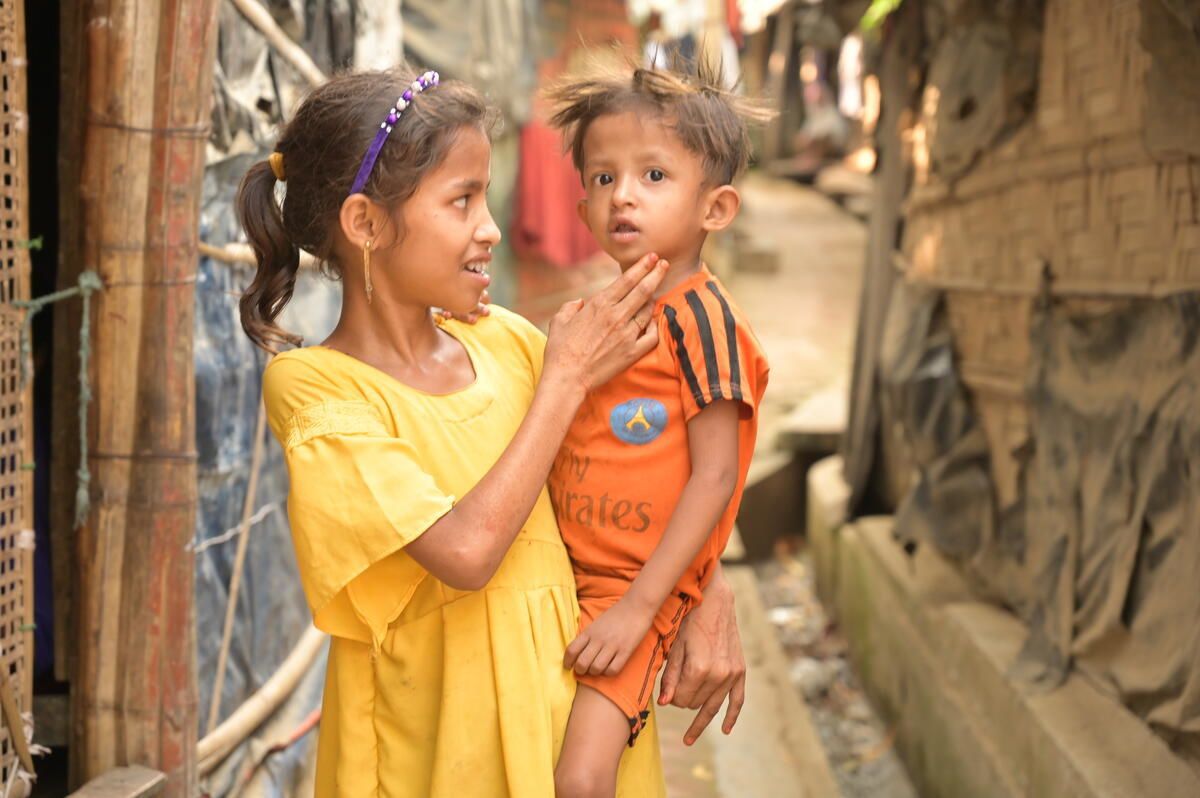Samira in Bangladesh

12-year-old Samira lives with her parents and five siblings in a refugee camp in Cox’s Bazaar, Bangladesh. Six years into the refugee crisis that led many families to flee from Myanmar, Samira and her family have survived multiple fires, cyclones and other disasters. Last year they also survived a funding shortfall, which led to a sharp reduction in general food assistance in the camp, and an increase in child malnutrition.[1]
“We used to play a lot back in Myanmar,” Samira remembers. “We would hang a cradle in the tree and swing. In Myanmar, we had plenty of trees that gave us fruits like mango, jackfruit, lemon, olive etc. We could eat those fruits, freshly picked from the trees. It was fun back in Myanmar.”
[1] WFP (31 Dec 2023). WFP to increase food ration from US$8 to US$10 for all Rohingya refugees in Cox’s Bazar
That was half her lifetime ago before Samira and her family fled the escalating violence at home for safety. “We couldn’t stay in Myanmar anymore. We had to leave. We came by boat [and] had to cross the river, forest, and hills.”
When the family arrived in Bangladesh, they had to move camps a few times, trying to rebuild a shelter, source clothes, and find some sense of normalcy each time. Learning and peace centres run by World Vision in the camps have helped give Samira and her siblings a new sense of normalcy, and World Vision and World Food Programme provided the family with an e-voucher to purchase rice, oil, and other food and spices.
However, ration cuts in 2023 made it clear just how precarious the family’s new normal was. “There was a ration cut last year on our food entitlement,” Samira remembers. “With the impact of the ration cut, we struggled with rice and other commodities that we used to purchase from e-vouchers.
Shortfalls in funding led the World Food Programme to reduce the value of food vouchers in Cox’s Bazaar from US$12 to $10 per month in March 2023 and to decrease the value again to $8 in June. “During the ration cut, we had to eat less. Often, we would run out of rice, oil, spices.” Samira explains. “We would try to fill our stomachs with water and go to sleep. Sometimes, I would wake up and feel hungry.”


World Food Programme’s data showed a sharp decrease in food consumption and an increase in negative coping mechanisms among the population as a result of the cuts. By November 2023, 90% of people had inadequate food consumption, a more than 10% increase from a few months earlier. “Sometimes I ate half [a meal] and went to school. Luckily, we were given a biscuit from the school which met our hunger.” Samira remembers.
From November 2023, World Vision began working with UNICEF and WFP in the camps providing essential nutrition supplements like the nutritional biscuits Samira mentions to more than 50,000 women and children in the camps. At the start of January 2024, the WFP also increased the value of the e-vouchers for the entire Rohingya population from US$8 to US$10 per person per month, with an extra US$3 for children under five, and gradually added locally fortified rice to its food assistance package.
“I wish to return to Myanmar. But with the ongoing war there, it’s impossible.” Samira says. “We had cows, buffalo, ducks, hens, and many trees that gave us fruits. But here, we can’t tend or grow anything.”
Although the ration cuts in the camps have been at least partially restored, the future for Samira and her family is still uncertain. She dreams of becoming a teacher, but gender norms and the threat of violence risk cutting her education short. She also dreams of seeing the beach – although living in a camp named for the longest beach in the world, she’s never been, and restrictions on movement make it uncertain. Samira and her family need food rations, for certain, but what they need even more are safety and peace.

For more on how ration cuts are affecting children and their families, please read World Vision’s new report here.
